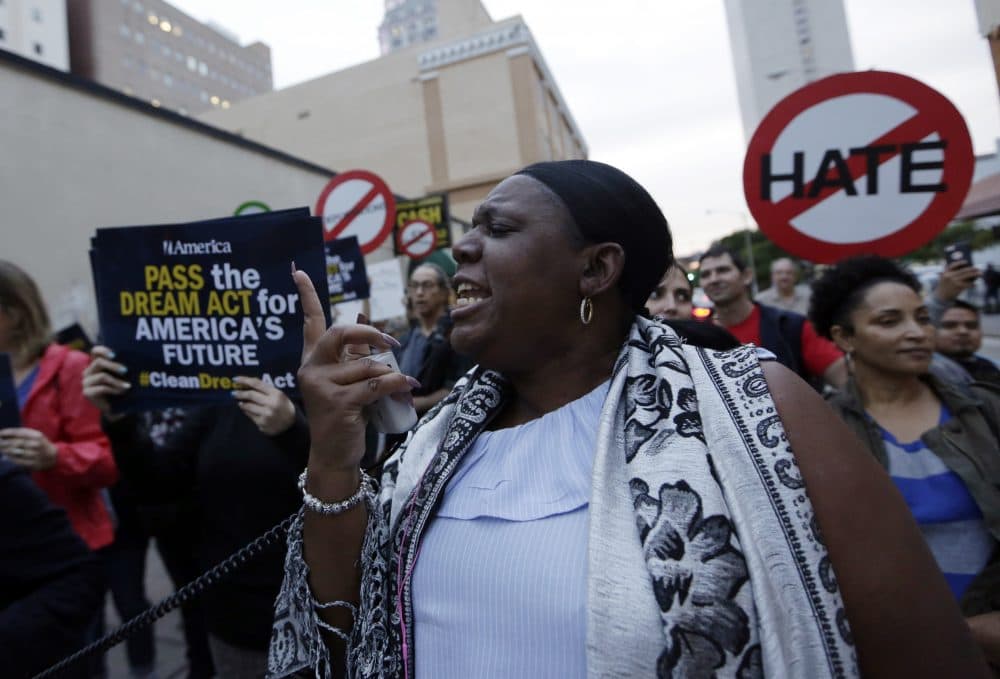Advertisement
Who Should Be Let Into America?

This week on Freak Out And Carry On, Ron Suskind and Heather Cox Richardson talk with Tom Gjelten, who covers religion and immigration for NPR. They discuss President Trump's ideas about immigration, and how they fit into the long debate over which people are allowed to come to America.
Excerpts
Ron Suskind: Heather, we're at a breaking point. The Democrats in the House and the Senate seem to be holding their ground, saying they're going to shut down the government unless Republicans allow a deal that will protect illegal immigrants who were brought here as children. It's fitting, I suppose, that this issue may cause the biggest legislative fight of the Trump presidency thus far. Trump built his political career in some ways on being aggressive in terms of his anti-immigration stances.
Heather Cox Richardson: I think the Republicans and Trump are trying to throw us back to the era before 1965, when we had a major bipartisan reworking of our immigration system that was designed to focus on skills and family ties rather than countries of origin. Trump and the Republican Party are calling for a system that really looks much like the laws we used to have, from before World War II, that did discriminate based on countries of origin — are you coming from Haiti? Are you coming from Norway?
Tom Gjelten: I think the bottom line is that President Trump just thinks there are too many immigrants coming into this country. That includes illegal immigrants — people who are here without papers — but also legal immigrants. He has said that we're getting too many bad people coming in, and he's not just referring to people coming here illegally. And he wants to take a pause. We're now at a point in our history where approximately 14 percent of the U.S. population was born outside the country. That is almost back to where we were in the beginning of the 20th century.
Ron Suskind: Tom, you wrote a book called A Nation of Nations: A Great American Immigration Story. [It was published on the 15th anniversary of a crucially important American immigration law, passed in 1965.]
Tom Gjelten: I don't think, in my judgment, any law passed in the 20th century was more important in terms of its effect on American society. American identity, as well as the character and the demographic profile of America, were all shaped by that law.
Ron Suskind: Help us understand across the 20th century how we evolved, and how we arrive at that extraordinary piece of legislation in 1965.
Tom Gjelten: Well, at the turn of the last century, there was a real flood of immigrants coming into this country. And while there were rules about who could come in, there wasn't a defined visa policy until the early years of the 20th century. And when those laws were enacted, it was on the basis of alleged scientific evidence about which countries produce the best people. There was a commission set up by Congress that went over to Europe and interviewed people, and ended up coming up with a 42-volume final report that included called the Dictionary of Races and Peoples, in which they offered generalizations about people from different countries, and what qualities they had. The Slavs were considered to be fanatical in religion, careless about punctuality, not respectful of honesty. Italians were considered to be excitable, impulsive, imaginative, but not very practical. The Scandinavians, on the other hand, were considered the purest type. And those kinds of prejudicial feelings then influenced our immigration policy. Congress came up with a system of allocating visas on the basis of where you came from. And there was an effort to bring in people with "good" qualities. More slots were reserved for people from Northern and Western Europe and fewer from countries in Asia and Africa. It was incredibly biased. And in the 1960s, there was an idea that we finally needed to get rid of this quota system altogether.
Heather Cox Richardson: So how did that play out, in the wake of World War II?
Tom Gjelten: It was really President Lyndon Johnson who made a big commitment to get rid of the national origin quota system. And his administration worked to bring that reform about.
Heather Cox Richardson: And that 1965 law also led to the concept of "chain migration," also known as "family reunification." Can you walk us through how that idea took hold in the 1960s?
Tom Gjelten: Yes. President Johnson's original reform proposal would have given first preference to immigrants who had skills in education and training that were considered especially advantageous to the country. But a Congressman from Ohio, Michael Feighan, made it clear that he didn't like that idea. And it was clear that he and his allies thought that this revamping of immigration policy would bring in people from countries in Africa or Asia that were considered "inferior." So he suggested that instead of having top preference go to people with certain skills and education, it should go to people with relatives here already. It's ironic. There was an idea in the 1960s that if you prioritized people who already had relatives here, you would get more of the same [kind of ethnicities] that you already had. And that proved to be completely erroneous. I think what happened is that they did not realize that the demand to move to the United States was no longer coming from Europe, but rather from the developing world. All you needed was one student coming here or one person coming with an employment visa and that person would have an entire extended family who wanted to follow them here. So giving preference to people based on their family ties really opened the door [to the immigration system we have now.]
The views and opinions expressed in this podcast are solely those of the participants and do not in any way reflect the views of WBUR management or its employees.

